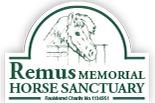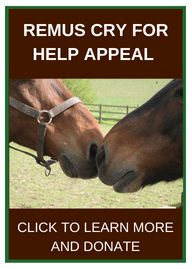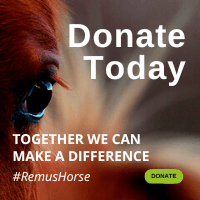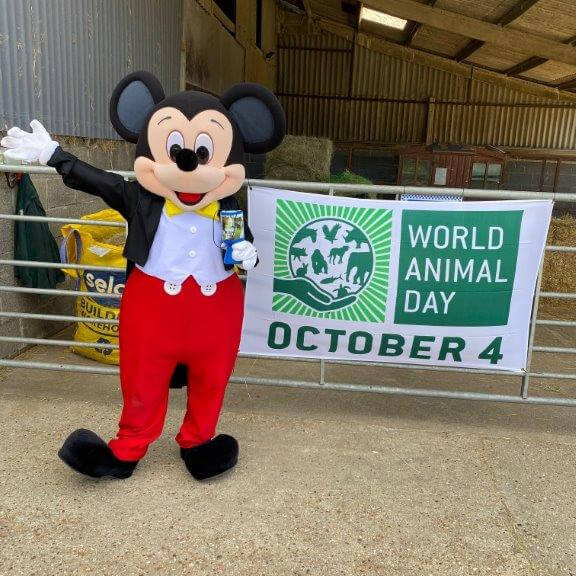
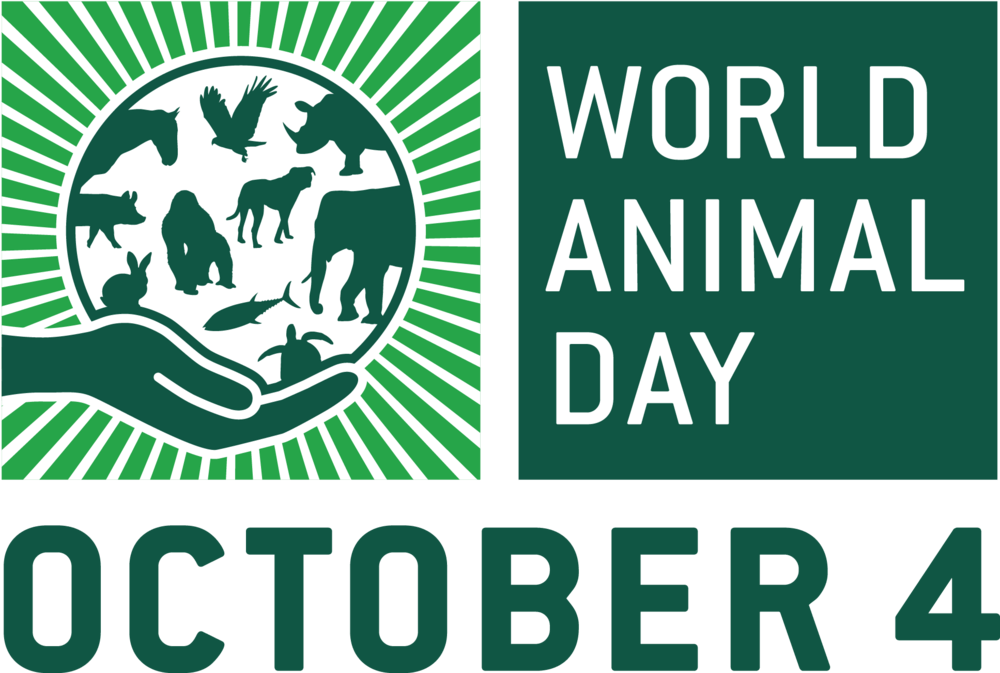
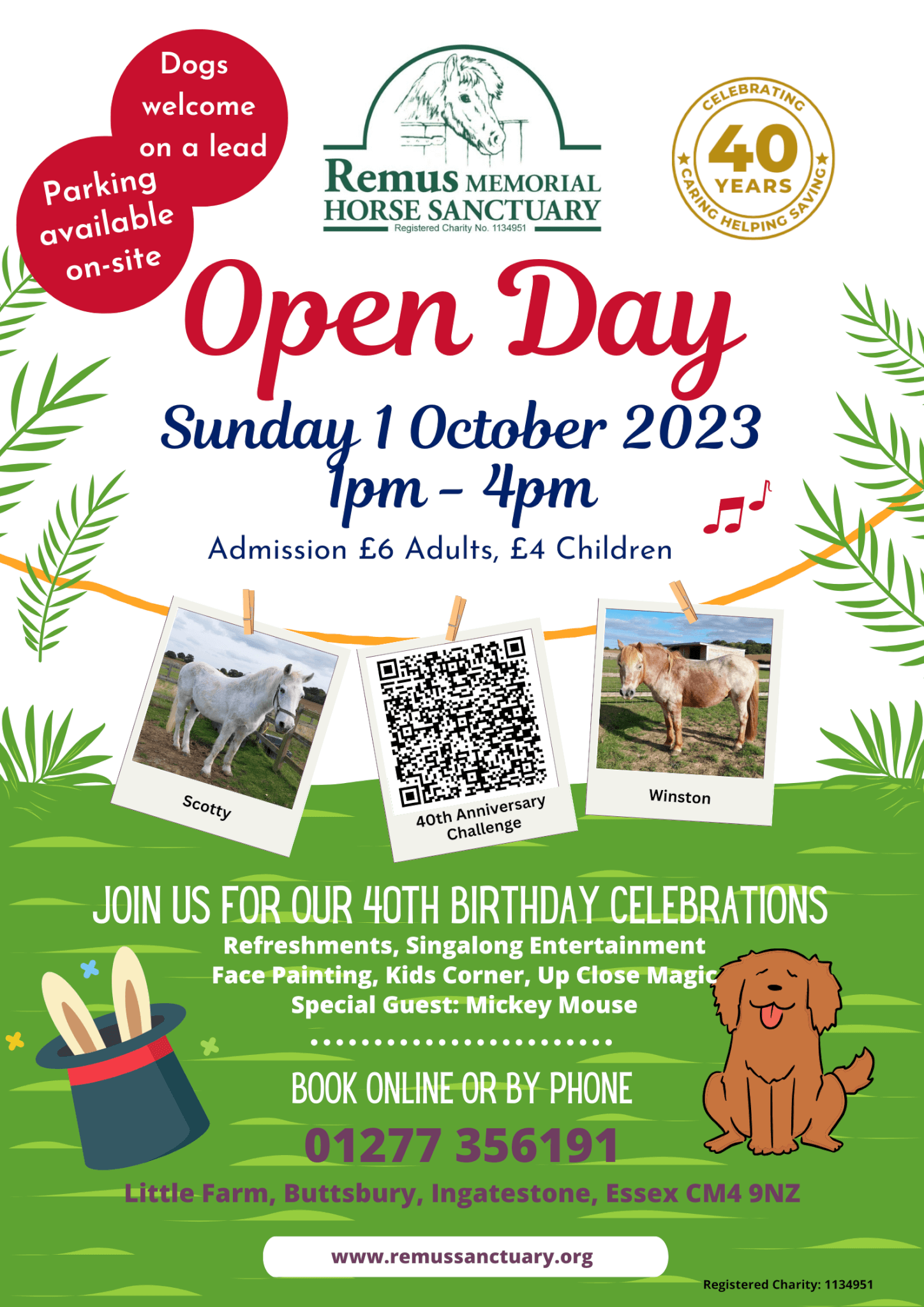
Celebrate World Animal Day with Remus
Join the animals, staff and volunteers for our last Open Day of the 2023 season and celebrate World Animal Day with us on Sunday 1 October from 1pm to 4pm. Disney’s character Mickey Mouse, will also be visiting during the afternoon!
World Animal Day, officially 4 October, has become a global celebration for all animals and the people who love and respect them. It’s known on every continent and celebrated in different ways in many countries, with no regard to nationality, religion or political ideology.
This year’s theme is ‘Great or Small, Love them All’, which we think is pretty perfect!
Founder of the Sanctuary, Sue Burton, says: “Here at Remus Horse Sanctuary we are proud to celebrate and support this global movement to raise the status of animals everywhere at our Open Day.
“World Animal Day makes a vital difference all over the world and It’s obviously close to our hearts here at the Sanctuary.”
Visitors are welcome at the Sanctuary from 1pm to 4pm and can enjoy meeting the 200+ animals and learn more about what the charity does. There will also be a variety of activities for the whole family, such as up close magic, facepainting, music, and many stalls to browse. Parking is available on-site, with disabled access, and dogs are of course welcome on a lead. Refreshments will be available throughout the afternoon. Entry is just £6 for adults and £4 for children.
Find out more and buy your tickets in advance at: www.remussanctuary.org/events/open-day-sanctuary-october.
The Sanctuary provides rehabilitation and care for around 200 animals, including horses, ponies, donkeys, goats, sheep and cats, and has been doing so since it was founded in 1983.
If you’re unable to join us on Sunday but would still like to make a donation, you can do so online via our website. Alternatively feel free to give us a call on 01277 356191 to make a donation over the telephone, or post us a cheque to: Remus Horse Sanctuary, Little Farm, Buttsbury, Near Ingatestone, Essex CM4 9NZ.
#BornToDie Campaign Calls for Greater Enforcement of Animal Welfare Act
Sue Burton, founder of Remus Horse Sanctuary, has launched her #BornToDie campaign whilst commemorating the 40th Anniversary of the charity earlier this summer. Ms Burton is calling for greater enforcement of the Animal Welfare Act in relation to equine welfare – saving horses, ponies, donkeys and mules.
Across the UK horses are being let down by those who fail to give the care that horses, ponies and other equines should be able to rely on as a very basic right. Mares are still being forced to breed every year, many on a tethering chain with their foals being born to a life they wouldn’t choose, and as Remus sees so often literally being Born to Die.
Ms Burton said, “We do have a whole raft of laws, but the problem lies with the enforcement. If the laws were enforced, then we would not have the ongoing welfare issues that we see so regularly.”
In December 2020, the Charity Times reported: “There are more than 7,000 horses currently known to animal welfare charities at risk of neglect or being abandoned. Currently charities take on more than 2,000 horse welfare cases a year.”
The police – who must be relied upon to enter property or confiscate animals, will often not investigate, telling Ms Burton that they “signpost the public to the RSPCA” – who have no statutory powers, and are already overstretched.
At the start of this year, Ms Burton asked two police forces either side of the Dartford Tunnel for data on equine neglect crimes; one said they didn’t collect that information and advised the public are asked to contact the RSPCA if they are aware of crimes against animals, and the other did not respond.
Improving the Effectiveness of Animal Welfare Enforcement by APGAW (All Party Parliamentary Group for Animal Welfare) confirmed that there is a huge level of inconsistency with some forces seeing the value of having officers dealing with animal welfare and recognising it can be connected to other types of crime and others not seeing any value. Furthermore, equines fall in between both companion and livestock legislation.
Local authorities can choose to appoint inspectors, but don’t have to – again many signposting to charities, including every local authority website that Ms Burton and her team researched in Essex. Different levels of authority have different responsibilities. For example, where a borough council is accountable for fly-grazing, a county council is responsible for the welfare of horses being transported.
At the 40th Anniversary luncheon held at Ingatestone Hall in Essex, attended by the charity’s Patrons, dignitaries and trustees, Ms Burton shared, “I have witnessed so many awful sights that I can never unsee. I have cried a lake of tears. I never fail to be stunned at how much suffering these stoic animals take, at how awful mankind can be to such noble innocent animals and how so many in authority ignore their plight due to deficiencies in our legal system.
“I am so proud of what Remus has achieved over the past 40 years and the animals who have come through our gates that we have been able to turn round – from emaciated, terrified, beaten, and in two cases deliberately blinded wrecks, to animals now able to live and enjoy a normal happy life free from suffering, hunger and fear.
“But what good is a law that isn’t enforced? Deficiencies in our legal system should not be the reason thousands of these noble innocent animals suffer each and every year.”
Ms Burton is calling for the following:
- a named post within every County Council and unitary Authority, responsible for enforcement action across the full range of equine cruelty, working with lower tier authorities, the police and charities.
- a national education programme, promoted across communities who are traditionally less likely to understand the importance of equine care, cascaded to support workers facilitating conversations with such communities.
- publication by each local authority of information relating to equine welfare cases, including the number of reports, attendances, investigations and prosecutions, and details of whether referrals have come through charities or members of the public.
Attendees at the luncheon included HRH The Duchess of Edinburgh GCVO, Royal Patron to the charity since 2013, two more of the charity’s patrons: Lord Petre and his son The Hon. Dominic Petre, and Andrew Rosindell MP for Romford; Mr Vincent Thompson, His Majesty’s Deputy Lieutenant; Mr Charles Bishop, High Sheriff of Essex; Councillor Jill Reeves, Chair of Essex County Council; Councillor Linda Mascot, Mayor of Chelmsford City Council; Mr Nick Eveleigh, the Chief Executive of Chelmsford City Council, and Mr Andy Mariner, Assistant Chief Constable of Essex Police. Along with the charity’s trustees, supporters, suppliers and vets.
Of the new #BornToDie campaign, Conservative MP for Romford Mr Andrew Rosindell commented: “The government needs to step up. I’m very committed as a former shadow minister for animal welfare to continue to raise these issues in parliament and to lobby the government to change the culture of animal welfare in this country and I’m committed to working with Remus to ensure that happens.”
Ms Burton concluded, “The Animal Welfare Act should ensure that all equines, and other kept animals, are protected.
“But the protection of these beautiful animals, who have stood with humans for centuries – from farming to war, from friendship to servitude – falls to charities often stretched for resources. Too often, members of the public have no information on how to act.
“Please, support our #BornToDie campaign for greater enforcement of the Animal Welfare Act in relation to equine welfare.”
For further information, visit www.remussanctuary.org/borntodie or contact Sue Burton on tel: 01277 356191 if you can help promote or add value to the campaign.
Remus will be hosting its final Open Day of the season on Sunday 1 October, in celebration of World Animal Day, for those wishing to visit the Sanctuary.
Luncheon images by Christopher Rushton.
Getting to the Bottom of it!
All the equines at Remus are under a strict worming programme which allows us to keep on top of any parasitic worm problems and assess the right treatment course. A worm burden for a horse can vary in its severity due to the horse’s age and any pre-existing health problems. In most cases a low worm burden number will cause very little problems to an individual but when this becomes high it can cause a horse to be in poor health, with loss of body condition and even colic.
Prevention is always the best course of action, and we undertake a few tasks and follow a few set rules to minimise the risk of problems occurring:
- Firstly, where possible, we try to keep on top of de-dunging our fields, this then concentrates any faecal eggs either into one pile in a field where the horse is unlikely to graze from, or it is brought up to the muckheap to then be taken off site.
- Secondly, we try to keep individuals in the same set groups and rarely move them around to different fields that have housed different animals over time. This then creates little ecosystems and populations of worm problems in set fields with set individuals in that field rather than a mass site infection.
- Lastly, we weigh all of our stabled horses weekly and the field horses on a monthly basis, which then flags up any that have suddenly lost a lot of weight in a short space of time as this can be indicative of a worm burden problem, as can some colics.
Every 12 weeks (depending on the type of wormer being used), we carry out dung samples for all of our equines to see what or if any faecal eggs are found and to what concentration. We don’t worm a horse unless a reading of more than 200 eggs per gram is given – you do not want to overuse wormers especially with the current climate of resistance to these products being increasingly found.
However, we do worm everyone at least once a year as well as give them a wormer for tapeworm which cannot be measured by doing faecal egg counts. The measurement for tapeworm requires a different test and the horse is treated with a different class of wormers for this problem. Everyone has a dung sample collected to be sent off to the laboratory for testing and then it’s posted off to the laboratory to undertake this screening.
As you can image, this is all both administratively burdensome and time consuming, and any donation you can make to help our ongoing costs would be very much appreciated.
Sadly our final Open Day of the season is swiftly approaching. Join us on Sunday 1 October for our last Open Day of 2023.
Fun Dog Show at Horse Sanctuary in Essex
Remus Horse Sanctuary will be opening its gates on Sunday 3 September to welcome Mrs Linda Mascot, the Mayor of Chelmsford, and members of the public for its fun Dog Show and Family Open Day from 1pm to 4pm. The Dog Show will commence at 1.30pm with bookings being taken from 1pm.
The Open Day and Dog Show will take place at Little Farm, Buttsbury, near Ingatestone, with free parking on-site, and disabled access. Admission is charged at £6 per adult and £4 for children. Cream Teas can be booked in advance for £15 per person, including entry. All dogs are welcome on a lead.
The popular novelty Dog Show includes fun classes such as: Bad Hair Day and Best Sausage Catcher, along with the more meaningful – Dogs with a Disability (blind, deaf or a life-changing illness) and of course, the ever-popular Best in Show. The 1st – 6th winners will each receive a rosette.
The events at the Sanctuary are always fun and interesting for the whole family, with a children’s entertainer, facepainting, live music and sing-a-long entertainment, delicious refreshments, lots of stalls, a tombola and a raffle.
The Open Days are a vital source of fundraising for the charity which, due to its location on greenbelt land, can only open to the public for a limited number of days each year.
The Sanctuary provides rehabilitation and care for around 200 animals, including horses, ponies, donkeys, goats, sheep and cats, and has been doing so since it was founded in 1983. As a result, the charity has created its 40th Anniversary Challenge this year to help raise awareness of the sheer number of animals being born to die. Details of the 40th Anniversary Challenge can be viewed at: donate.giveasyoulive.com/campaign/40-anniversary-challenge.
Sue Burton, founder of the Sanctuary says, “Our fun dog show always offers a new dimension to our Open Days and we look forward to welcoming our visitors to learn more about what we do here.
“Young and old always have such a great time. They get to meet our amazing animals and we give them an insight into our valuable work in a fun way.”
To book tickets for the Open Day and Dog Show, visit the charity’s website at: www.remussanctuary.org/events/open-day-sanctuary-september.
For anyone wishing to sponsor a dog class at the event, especially local businesses, please email: info@remussanctuary.org. Further information is available on the website at www.remussanctuary.org and the charity’s Facebook page or contact Sue Burton on tel: 01277 356191.
Keeping Veteran Horses Active
We have some wonderful ‘golden oldies’ at Remus Horse Sanctuary, and while the horses that end up with us or that we rescue may not have been well looked after by previous owners, there’s no reason why veterans can’t live active lives in their twilight years.
Even in their twenties, horses can still work; with some TLC, patience and adjustments, they can even continue to compete if you want to. Of course, our rescue animals here at the Sanctuary have a life built around them giving them all they need and asking nothing of them.
The key is to take things slowly and be aware that attaining and keeping a level of fitness may take some time. Building up the amount of work – and this may mean several weeks of walking exercise before moving on to anything else – will reduce the likelihood of injury.
Keep exercise sessions regular and short, and make sure you allow plenty of warming up and cooling down time too.
Of course, there will be a time when they can’t perform at your required level – it’s important to recognise this and make adjustment to avoid putting them at any risk. Look out for stiffness, lameness and loss of condition as key signs. There’s plenty more advice in this excellent article at www.yourhorse.co.uk/horse-care/keeping-veteran-in-ridden-work/.
As you will know, it’s our 40th Anniversary this year and we are campaigning to stop any equine (so horses, donkeys and mules) being born to die. Find out more about our #BornToDie campaign on our website and please fundraise for our 40th Anniversary Challenge too!
The True Cost of Horse Ownership
Keeping a horse is not a cheap hobby – and with the cost of living crisis, the expense of horse ownership has never been more keenly discussed.
At Remus we sadly often see the results when owners cannot afford to keep horses properly – whether they come to us because corners have been cut in their health and welfare, or whether owners are looking to rehome because they can no longer afford to keep their horses amid rising bills or a change in personal circumstances.
That’s why we make it part of our mission to educate would-be owners on the true costs of the hobby. Along with the actual purchase cost of your animal, there are insurance premiums to be paid, vets bills, feed, hay and livery if you don’t have your own place to keep your horse. That’s before you add in the cost of tack and other kit, transport and lessons.
The excellent Horse and Hound feature at www.horseandhound.co.uk/features/10-ways-save-money-livery-bill-431963 lists some ways to help keep costs down, including sharing costs with other owners, selling unwanted tack, taking on jobs at the livery yard, and sharing rarely needed kit and transport costs.
It’s important to note that none of these ideas sacrifice the quality of care and welfare for your animal – a concern that should always be uppermost in owners’ minds.
If you are paying for livery, although cost will be a major consideration, you should also ensure that corners are not being cut to get that good deal. Find out more about the true cost of livery at www.horseandhound.co.uk/news/why-owners-and-livery-yards-must-appreciate-the-true-cost-of-keeping-horses.
This year Remus is celebrating its 40th anniversary. If you’ve not yet done so, please take a look at our 40th Anniversary Challenge and share with your friends and family to help us achieve our mission.
HRH The Duchess of Edinburgh Visits Horse Sanctuary to Commemorate 40th Anniversary
On Tuesday 27 June 2023, HRH The Duchess of Edinburgh visited Remus Horse Sanctuary to commemorate its 40th anniversary.
The Duchess, who has been a patron of the charity since 2013, toured the Sanctuary and unveiled a commemorative plaque with founder, Sue Burton. The Duchess spoke to many members of the Remus team and volunteers, thanking them for their hard work and support.
During the visit to the Sanctuary, The Duchess was joined by Mr Vincent Thompson, His Majesty’s Deputy Lieutenant; Mr Charles Bishop, High Sheriff of Essex; Councillor Jill Reeves, Chair of Essex County Council; Councillor Linda Mascot, Mayor of Chelmsford City Council; Mr Nick Eveleigh, the Chief Executive of Chelmsford City Council, and Mr Andy Mariner, Assistant Chief Constable of Essex Police, before enjoying an anniversary lunch at the nearby and historic Ingatestone Hall with two more of the charity’s patrons: Lord Petre and his son The Hon. Dominic Petre, and Andrew Rosindell MP for Romford. Also in attendance at the lunch were many of Remus’ trustees, supporters, suppliers and vets.
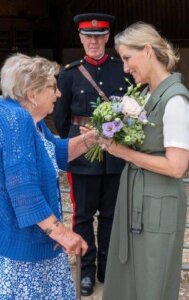 Mrs Doreen Lowman, 95, a local fundraiser and long-term supporter of the Sanctuary presented The Duchess with a small posy of flowers. This is the Duchess’ first visit to the Sanctuary since her change in title earlier this year.
Mrs Doreen Lowman, 95, a local fundraiser and long-term supporter of the Sanctuary presented The Duchess with a small posy of flowers. This is the Duchess’ first visit to the Sanctuary since her change in title earlier this year.
Founder, Sue Burton, thanked the Duchess for her time, saying: “I am so very proud to still be in the driving seat of Remus after 40 years. 40 years of helping animals but particularly equines.
“I am proud of what Remus has achieved in that time and the animals who have come through our gates that we have been able to turn round, from emaciated, terrified, beaten, and in two cases deliberately blinded wrecks, to animals now able to live and enjoy a normal happy life free from suffering, hunger and fear. To my mind these things should be a very basic right, not a privilege.
“I am proud to have Her Royal Highness here supporting our work. It’s a massive achievement and we, I, am so grateful that you could take the time from your busy schedule to be with us today Ma’am. Thank you so much.“
For further information on the welfare work of Remus Horse Sanctuary, visit www.remussanctuary.org or contact Sue Burton on tel: 01277 356191.
Images (credit Christopher Rushton):
- Remus Founder Sue Burton and HRH The Duchess of Edinburgh with commemorative plaque
- HRH The Duchess of Edinburgh meets rescue Dolly, our eldest horse, 39yrs
- HRH The Duchess of Edinburgh meets rescue cat Smudge
Fun Dog Show and Family Day Out in Essex
Remus Horse Sanctuary will be opening its gates on Sunday 2 July to welcome members of the public for its fun Dog Show and Family Day from 1pm to 4pm. The Dog Show will commence at 2pm with bookings being taken from 1.30pm. Visitors will be able to meet Special Guest Minnie Mouse who will be making an appearance during the afternoon.
Open Days at the Sanctuary at Little Farm, Buttsbury, near Ingatestone, offer free parking on-site, with disabled access. Admission is charged at just £6 per adult and £4 for children. Cream Teas can be booked in advance for £15 per person, including entry. All dogs are welcome on a lead.
The popular novelty Dog Show includes fun classes such as: Bad Hair Day and Best Sausage Catcher, along with the more meaningful – Dogs with a Disability (blind, deaf or a life-changing illness) and of course, the ever-popular Best in Show. The 1st – 6th winner receives a rosette.
The events at the Sanctuary are always fun and interesting for the whole family, with a children’s entertainer, facepainting, live music and sing-a-long entertainment, delicious refreshments, lots of stalls, a tombola and a raffle.
The Open Days are a vital source of fundraising for the charity which, due to its location on greenbelt land, can only open to the public for a limited number of days each year.
The Sanctuary provides rehabilitation and care for around 200 animals, including horses, ponies, donkeys, goats, sheep and cats, and has been doing so since it was founded in 1983. As a result, the charity has created its 40th Anniversary Challenge this year to help raise awareness of the sheer number of animals being born to die. Details of the 40th Anniversary Challenge can be viewed at: donate.giveasyoulive.com/campaign/40-anniversary-challenge.
Sue Burton, founder of the Sanctuary says, “Our fun dog shows offer a new dimension to our Open Days and we always look forward to inviting visitors to come and visit the Sanctuary and learn more about what we do.
“Young and old always have such a great time here. They get to meet some of our amazing animals and we give them an insight into the valuable work that we do in a fun way.
”This year is particularly special as we’re celebrating our 40th anniversary.”
To book tickets for the Open Day and Dog Show, visit the charity’s website at: www.remussanctuary.org/events/open-day-at-the-sanctuary-july.
For anyone wishing to sponsor a dog class at the event, especially local businesses, please email: info@remussanctuary.org. Further information is available on the website at www.remussanctuary.org and the charity’s Facebook page or contact Sue Burton on tel: 01277 356191.
The Rescue of Benjamin and his Friends
Sue Burton and her team have rescued thousands of animals over the past 40 years. Here she recalls the 40th animal that the charity rescued…
“I recall getting a phone call about some horses in Essex one snowy winter’s evening. We stumbled over fields that were 3 to 4 ft deep in snow. I gave up trying to count how many times I fell over in the pitch dark!”
When Sue and her colleagues entered the barn they stopped dead in their tracks – an animal Belsen was presented before them. The poor, poor ponies were emaciated, with large bald areas due to lice infestation. The sight of such vulnerable animals which were obviously being so cruelly and horrifically treated, was beyond comprehension. Sue said they couldn’t believe what they were seeing! The animals had no food, no water and no bedding. Their urine was frozen to the ground, and they stood in piles of dung. Every single one of their ‘five freedoms’ had been taken away from these dear creatures. It is a sight that Sue will never forget.
“The youngsters had never been let out of the barn and didn’t seem to know how to walk.”
When the horses could be taken out the next day, the youngsters’ legs had to be moved for them – literally – they didn’t appear to be able to walk. Their joints were stiff and frozen with cold and inactivity.
The bigger one, we called him Benjamin, had a wooden stake rammed through his stifle. We have every reason to believe that this was done to him on purpose, and the vicious injury continued to cause him problems throughout the rest of his life. The stifle is the largest joint in the horse’s body and the site where the femur meets the tibia in the hind end. You can see the ‘before’ photo of Benjamin, a shadow of the horse he was meant to be. Sue says that seeing the second photo of the horse that Benjamin became is still so emotional.
“When we were trying to get Benjamin out of the barn the owner kept slamming the door against his broken body.”
Sue and her team took five horses out that day with the owner constantly threatening everyone with a kitchen knife.
As well as Benjamin, they were Dolly, Velvet, Toby, and Charlie. All of them were aged from 6 months to just 3 years old. Getting them well became all-consuming and the team worked so hard to give them the best they could, to allow them to go on to lead healthy lives and to forget about all they had experienced at such a young age.
Dolly had a paralysed soft palate and went on to live a life where everything she ate had to be managed, just to prevent her from choking to death. But obviously they all had their issues because of what they had suffered emotionally, mentally, and physically. Yet with Remus’ care they all managed to live into their late teens and early 20’s. They were all such loving ponies and so didn’t deserve how they had been treated. Does any animal ever deserve that kind of treatment?
This particular rescue operation took just two days, but in some cases it can take weeks and even months, running into tens of thousands of pounds. As you’ve no doubt realised from the story of Benjamin and his friends above, the cost is not restricted just to the rescue but must also encompass their ongoing specialist care.
Your support made this rescue mission possible.
Please, help us to help more animals and stop them from being born to die, by participating in our 40th Anniversary Challenge. If you’re a business, you’ll be pleased to hear you can also support us. Please sign up as a Corporate member with Give as you Live first.
Are you up for the challenge?
#NeverBornToDie
Raise Free Funds for Remus
We’ve got lots of ideas on our website on how you can help us, but here’s a quick update about some other ‘Give As You Live’ donations you might not be aware of!
- Donations on Fuel – Thanks to Morrisons, Give as you Live members like you can now raise donations when you fill up at the pump, and pay using a Give as you Live Instore Morrisons card – a handy pre-paid payment card. Just order your free card, top-up when it suits you, and use it to pay for your fuel.
- Donations on Meals – Did you know that you could raise donations on the table bookings you makes for special occasions with your family and friends? If you use Give as you Live Online, you can earn 50p per booking at lots of restaurants, or you can raise donations on the whole bill by paying with a Give as you Live Instore card at 12 different restaurant chains, including Nando’s, Harvester and Turtle Bay!
- Donations at Ikea – It’s true – Ikea have joined the Give as you Live family and are offering donations of 2.5% when you buy an eVoucher. These are delivered straight to your inbox or can be gifted to friends and family. Just scan your voucher from your phone at the till – no need to print!
There are also a whole host of additional donations available via Give as you Live Instore – you could raise for Remus Memorial Horse Sanctuary on everything from your Spotify subscription to multi-store gift cards covering travel, entertainment and fashion favourites – they make great presents!
Quick, go check out Give as you Live Instore now!
